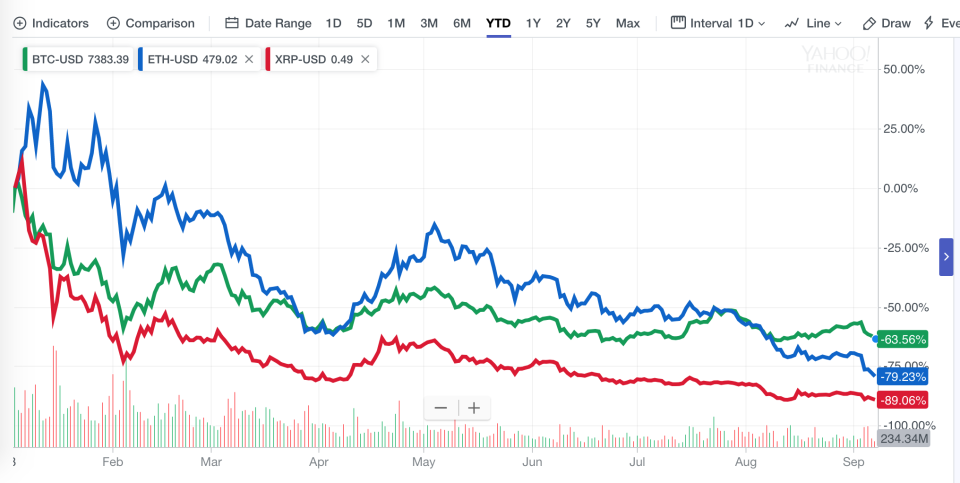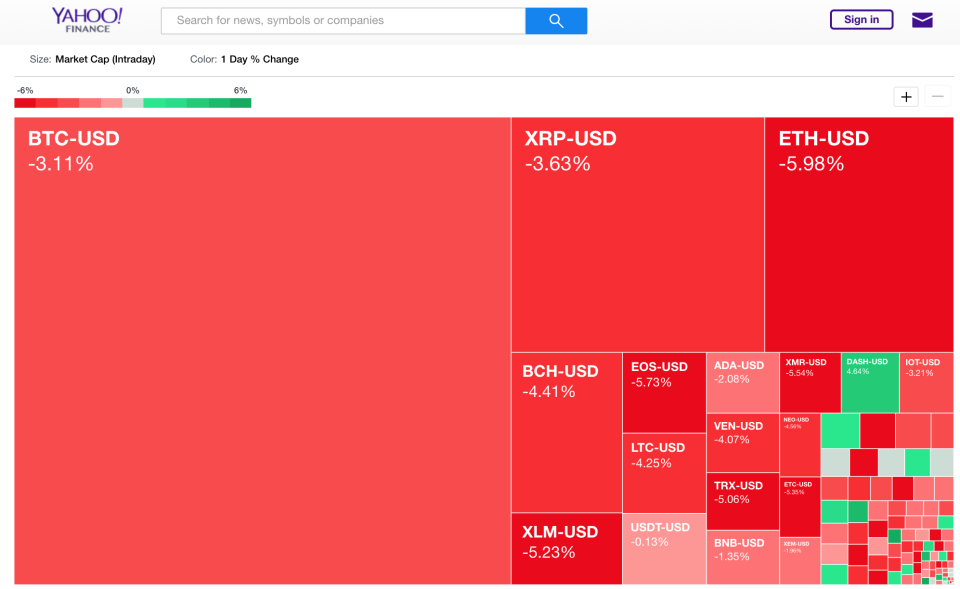Amid 2018 crypto crash, 3 kinds of believers come into focus
On Dec. 7, 2017, the price of bitcoin was above $17,000. Nine months later, it’s below $7,000.
Bitcoin (BTC), the primary cryptocurrency, is down more than 60% in 2018. The rest of the market looks even worse. Bitcoin has not taken as brutal a hit as most of the other cryptocurrencies this year, but it has recently shown a closer correlation with all the other coins than in the past, which means that altcoins are pulling bitcoin down with them.
Ether (ETH), the token of the Ethereum network, is down more than 75% in 2018 and has lost its spot as the No. 2 cryptocurrency by market cap to ripple (XRP), which is down more than 85% in 2018. Rounding out the top five coins by market cap are bitcoin cash (BCH), down more than 80%, and stellar lumens (XLM), down more than 60%.
The cryptocurrency market in 2018 is ugly, and some people are panicking.

But as always in crypto, misconceptions and misinformation are circulating. So it helps to take a look at the facts, as well as the varying reasons why believers still see cryptocurrencies as viable financial instruments.
Why crypto prices are down
On Wednesday, Business Insider reported that Goldman Sachs was ditching its plans to launch a crypto futures trading desk. But by the next day, Goldman CFO Martin Chavez called the report “fake news.” He also said Goldman’s entire crypto strategy is still in “exploration” mode, which suggests that the initial hype around Goldman’s crypto interest, ignited by a report in May, was overblown all along.
The reality is that crypto prices have been plummeting this year due to multiple major concerns, all of which are more macro than conjecture about what Goldman Sachs does or doesn’t want to do with bitcoin. (Most likely, the bank doesn’t actually know yet.)

There are serious concerns about whether the SEC will ever approve of a bitcoin ETF (exchange-traded fund), an investment vehicle seen as crucial to bringing legitimacy to crypto trading. In July, the SEC rejected a bitcoin ETF (exchange-traded fund) from Cameron and Tyler Winklevoss for the second time. In August, the SEC delayed its decision on a bitcoin ETF from Van Eck, with a decision now expected in late September.
There are also fears about ether, which has fallen the farthest in recent weeks of any major coin. Many of the scores of startups that held ICOs (initial coin offerings), which are typically conducted in ether, either rushed to cash out their ether or failed entirely. The proliferation of scammy ICOs has cast a negative light on Ethereum.
And then there are the issues regarding tether, a “stablecoin” pegged to the value of the U.S. dollar and believed by many to be the driving force behind bitcoin price manipulation at the end of 2017. Tether, the company behind tether tokens, was subpoenaed by the CFTC in December along with the crypto exchange Bitfinex, and in May the CFTC and Department of Justice launched a criminal investigation into manipulation of bitcoin prices. The findings of that probe are still unknown, creating even more uncertainty.
Crypto believers hold on
And yet, amidst the 2018 crash, there remains a huge ecosystem supporting cryptocurrencies and their future as financial instruments. These believers typically fall into one of three factions:
1. Coin speculators: These are people who may not be convinced bitcoin or other cryptocurrencies have a future as an important technology but are buying, holding, and trading crypto as a speculative investment. They want coins to rise for the sake of their return.
Many of these are the institutional investors and new funds that have rushed in. This group also includes people who bought up bitcoin, ether, litecoin, ripple, and other coins during the run-up at the end of 2017, in the hope that prices would rise further. (They did the opposite.) Some of those folks, according to sad stories you can easily find, bought high last year and sold low this year in a panic. Others held their coins and are eager and anxious to see them go back up.
Amid the fervor, established fintech players like Robinhood and Square set up easy crypto buying options as a way to cater to curious newbies who want to invest.

Morgan Creek Capital Partners is just one of many examples of established hedge funds that have hastened to set up crypto trading operations. Morgan Creek is launching a crypto index in partnership with Bitwise.
“We had inbound interest from institutional investors saying, ‘How do we get exposure to crypto?'” CEO Mark Yusko said on Yahoo Finance’s Midday Movers show. “Our hashtag is #GetOffZero. Zero is the wrong allocation to this asset going forward.”
The new 80/20 portfolio
— Jon Aguiar (@JonAguiar) August 29, 2018
2. Blockchain, not bitcoin: These are the big banks or traditional Wall Street types who have dismissed the viability of bitcoin, the cryptocurrency, but keep hyping the applications of blockchain technology.
Bitcoin believers insist the two go hand in hand, and that it’s silly to try to divorce them. After all, the argument goes, blockchain (a decentralized, peer-to-peer ledger) originated with the invention of bitcoin in 2009. But as crypto prices remain volatile, traditional types have voiced interest in implementing distributed ledger technology without having to touch cryptocurrencies.
JPMorgan CEO Jamie Dimon is among this group. Dimon told the Harvard Business Review last month that cryptocurrency is, “not the same as gold or fiat currencies. Those are supported by law, police, courts. They’re not replicable, and there are strictures on them. Blockchain, on the other hand, is real. We’re testing it and will use it for a whole lot of things.”
Even those who dismiss bitcoin but see value in blockchain should be rooting for the success of the ecosystem, given that successful use cases for blockchain would (hypothetically) buoy the digital assets that are traded on blockchains.

3. Bitcoin believers: This group includes the bitcoin enthusiasts who have believed in the space since the early days: developers, programmers, and entrepreneurs who still think bitcoin (or other cryptocurrencies) will fuel a revolution in financial technology. They believe in the power of digital assets themselves, not just the rails they run on.
You could put many of the earliest, well-funded crypto startups in this camp, like Coinbase, which some have called the Goldman Sachs or Google of crypto, or Blockchain, the biggest provider of free wallet software for storing your crypto. You can include here not just bitcoin maximalists but those bullish on ether, or stellar lumens, or any other tokenized assets.
These folks often use the phrase “internet of money.” Balaji Srinivasan, founder of the bitcoin startup Earn.com (which Coinbase acquired this year), framed this vision to Yahoo Finance in 2016: Bitcoin can create a “machine economy” that would, “effectively rent or sell resources to other computers.” In other words, it would be an internet of money that has all kinds of positive implications for needs such as paying for online content or storing a contract. That hasn’t exactly happened yet, but crypto believers are convinced it will.

The people in this group mostly scoff at the idea of “blockchain without bitcoin.” As Chain CEO Adam Ludwin said at Yahoo Finance’s All Markets Summit: Crypto in New York in February: “Think of the asset first, not the architecture first.”
Anticipating the ‘trust net’
Of course, none of this is to say that people can’t fit into more than one of those groups. There are certainly many crypto traders who are trading these assets because they do believe in the long-term future of the technology.
Morgan Creek’s Yusko is one such believer — or at least claims to be. He says cryptocurrencies and the rails they run on will bring about “the ‘trust net,’ which is I think going to start in 2024.”
The bottom line: With so many people still holding on to crypto, for whatever reason, the assets are here to stay, regardless of the highs and lows of price drama.
—
Daniel Roberts covers cryptocurrency and blockchain at Yahoo Finance. Follow him on Twitter @readDanwrite.
Read more:
Crypto market crash prompts people to post suicide hotline on Reddit
Exclusive: Former FBI director Louis Freeh talks Tether investigation
Bitcoin VC: ‘People are going to lose a lot of money’ on new coins

 Yahoo Finance
Yahoo Finance 
